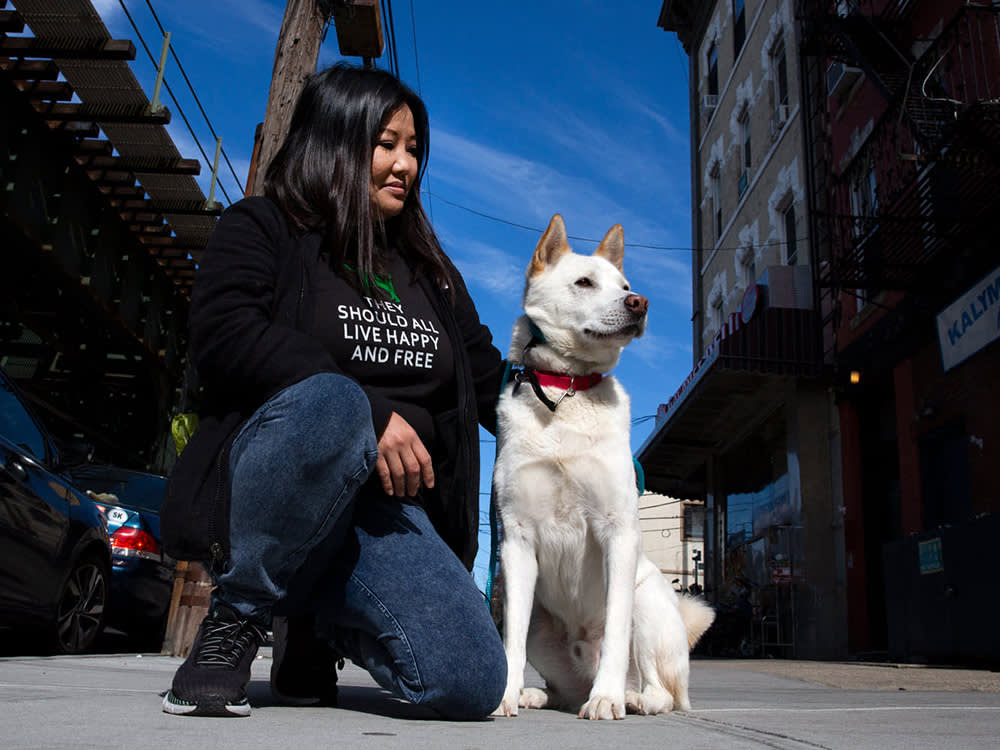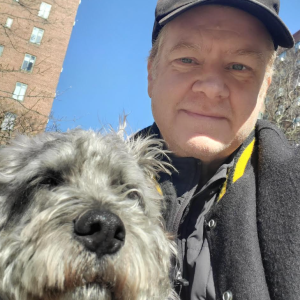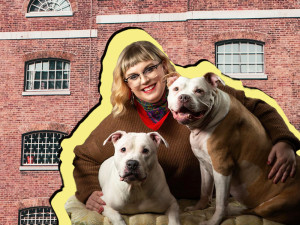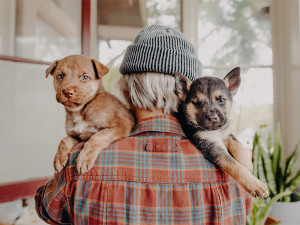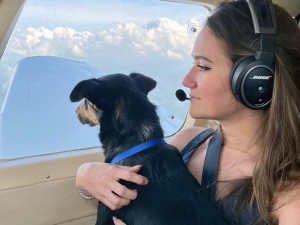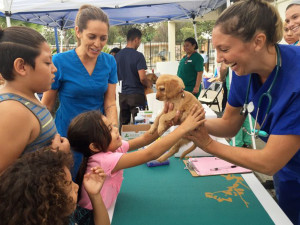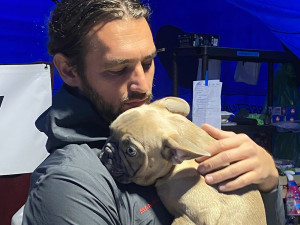How Korean K9 Gives Dogs Rescued From the Meat Trade a Second Shot at Life
The rescue’s founder, Gina Boehler, on her mission to help these pups start over.
Who’s waiting for Gina Boehler when she gets home? Well, for starters, there’s a 17-year-old Dachshund named Cena — yes, like John Cena, the wrestler — who was born blind and deaf. Then there’s Anne, a spark plug of a Jack Russell Terrier from a high-kill shelter in Korea, who was adopted (and returned) four times. And finally there’s Lovia, an abandoned Korean Village Dog, who was kicked as a puppy, suffering a broken hipbone that will never heal. She walks with a little limp.
It will take more than a full house of rescue pups to daunt Boehler, who started rescuing dogs and cats in 2012 and founded Korean K9 Rescueopens in new tab in 2017. The New York City-based operation finds fosters in the city for the dogs who were rescued and transported from Korean dog-meat farms, high-kill shelters, and slaughterhouses. Then, the goal is for them to find their homes with adopters — some whose names you might recognize, like Crazy Rich Asians star Awkwafina. Since their founding, the rescue has saved 2,500 dogs to be exact.
Trick question: All dogs are perfect! But find out which type is the best fit for you.
For Boehler, doing nothing for brave, hard-luck dogs like Cena, Anne, and Lovia was never an option. Not then. Not now. We recently talked with her over Zoom, while she was at home in the Queens borough of New York City — with Anne bouncing on her lap and smudging her nose on the computer screen.
Tell me about what led you to start Korean K9.
I went to Korea in 2017 to visit my family and took a tour of a rescue facility in a rural area of Gimpo, Korea, because I was curious about what the homeless dog situation looked like. About 300 feet down the road from the rescue facility stood a dog meat farm with over 200 dogs caged in squalor and filth, being raised for consumption. It was an image I could never forget that burned into my mind and heart, and I felt helpless.
How much do you spend on your pet per year?
The dogs were spinning in their small rusty cages without protection from the outdoor elements, eating rotten food waste and defecating through their steel-grate floor or into a massive mountain of feces in the middle of their small cage. I bore witness to the extreme cruelty and neglect of precious living beings who deserved better than to be born into a life of cruelty, neglect, and torture ending in their inevitable death for human consumption.
After you left the rescue and Korea, how were you affected by what you saw?
Even though we regard dogs as companion animals, the suffering was still the same, and the pain in their eyes haunted me every day. After I left Korea, I thought about how these dogs had absolutely no place to go after the rescue and how many would still live in cages even after their rescue — the activists working to free the dogs had no outlet or hope for the dogs to live as pet dogs.
With my volunteer background in animal rescue in NYC and activism, I could make a difference. I was working a full-time job then and never dreamed of quitting. Until one dog became 12 dogs and 12 became 24, I knew I had to quit my full-time office job if I wanted to make a difference. Two years after I started KK9R, I finally quit and haven’t looked back yet.
So, let’s talk about how things work these days. How do the dozen or so dogs you rescue weekly get from Korea to New York?
We have a flight volunteer program; if you’re traveling from Inchon to New York for business, work, vacation, whatever it is, and you have a direct flight, you can volunteer to take a dog with you as excess baggage, which [basically means that] they ride in the pet section of the airplane. It’s a cargo pet section that’s, like, temperature-controlled and pressure-controlled; it’s just like riding in the main cabin.
And you have a facility in Korea now. Can you share how that started and built to what it is now? How many staff and volunteers do you have there?
We opened our KK9 Bundang rescue center in March 2020, just a few weeks before COVID-19 became a worldwide pandemic and shut down our entire operations for a few months. Fortunately, we found a way to recover by fundraising and shipping our dogs via cargo rather than depending on flight volunteers who were not flying for six months during the worst part of the pandemic.
Our facility in Korea is located right outside of Bundang City [and is] about 20,000 square feet. We hold 125 to 150 dogs at a time and employ 10 trainers to care for them 24/7. Over 35 volunteers visit and help the dogs at our center every weekend. Our dogs receive nutritious food, vetting, and rehabilitation training to prepare them for their journey to a new country and life.
I am very proud of our team in Korea; they keep our facility clean, and the dogs are well fed and happy because of the constant work we do to create a positive and loving relationship with all humans they come in contact with after living through extreme cruelty, neglect, and trauma. It takes a village, and each week we see more and more Korean [residents] volunteering to make a difference by coming to our center and interacting [with] and walking the dogs.
When the dogs arrive in New York, is there a lot of rehab that needs to be done?
If they come from trauma situations like the dog-meat trade or puppy mills, they’ve had no positive experience with humans whatsoever. We have 10 trainers at our center that are hand-feeding timid dogs to begin with, just so they get our scent and our touch. And then we move on to other things, like walking on a leash and being touched by a human. It’s a lot of work and patience and time, but the end result is that they get a great home, so it’s worth it.
Do you see dog-meat farming as a steadily declining industry in Korea?
Yes. Because the government has played a big part in cracking down on illegal dog-meat farms. The agricultural department in Korea will say, “Hey, you’re not disposing of dog waste properly,” and they will come in and shut the [farm] down because of improper disposal. I mean 10 years ago, it was a different story. There were 17,000 dog-meat farms across the country, in the countryside. Rescue organizations in Korea say now it’s about half of that or less. It’s a very small segment of the population that actually consumes dog meat. Nobody thinks it’s a good thing.
Why do you think larger dogs are not being adopted in Korea?
It’s the same thing as in New York — people live in these small compartmentalized apartments, which are even smaller in the cities, and they just don’t feel comfortable taking out a big dog or a medium-size dog.
What’s the biggest challenge for adopters of these rescues?
Good question. People have expectations — they don’t want a dog that barks too much or a dog they have to exercise a lot. I think sometimes people envision the perfect kind of dog that they want, and then they come to our rescue group and they’re like, “Can you give me a dog like that?” We primarily specialize in trauma dogs but just give them time, and they will be amazing, amazing companions with a full blown-out character and personality you would never have imagined when you adopted.
Your job must take a take a real emotional toll on you.
Yeah, it’s a roller coaster. We just took this local Pit Bull who was left in an abandoned drug house and laying in front with cockroaches and cockroach bombs, just knowing nothing good is gonna happen unless we take her. And then you have extreme stories of boiling hot water being poured on one of our dogs in Korea that just got adopted and half of her face is missing. There are all kinds of situations and extreme cases that take a toll.
How do you deal with it?
I try to focus on the end goal, and that end goal is to find the right match and make sure that the [dogs get] what they need, and the [humans adopters get] what [they] need. There are success stories and people uplifting us, especially our Korean K9 community. We have a wonderful group of adopters [who] just understand, you know, what it takes to adopt [these dogs] and own one...that kind of stuff really is uplifting. [It] overshadows, you know, all the stuff that you see that is horrific. That’s how we look at it.
What are Korean K9’s future plans?
We are expanding to Los Angeles. It’s got great weather and a lot of great dog lovers out there. I think they’ll really like our Korean rescue dogs, and the dogs will have a lot of space to run, so we’re excited for that.
Did you have a childhood dog? There has to have been one dog who started your passion for what you do now.
Yeah. In the summertime I would put a tent out in our backyard and [my brown Cocker Spaniel] Fudgie would sleep with me in the tent and we would have, like, sleepovers with him. My memories of him are crawling inside a cool tent with me and keeping me warm.
What’s the most important thing you have ever learned from the dogs in your life?
My gosh. I guess that would be patience. I have two that are kind of disabled in a way, and they’re the most patient beings that I’ve ever met. They will wait for me if I’m five hours into being at the office and can’t come home to walk them. It’s hard to put into words how special each one is and how much they affect your life on a daily basis…But, yeah. I really think it’s patience.
